
The D4, Kings Arms, Auckland, 10 August 2002 - Photo by Mark Roach
There was a time in the 1990s when electronic music threatened to make indie guitar music redundant, with dance parties pulling massive crowds and thumping bangers soaking up the airwaves on student radio. While some rock groups tried to update their sound with samples and turntables, others went back to basics – returning to the roots of rock’n’roll and catching a wave that took them across the world.
Rock’n’roll has always drawn energy from its roots, sometimes dipping back to the genres that came before it, as in the 70s when blues-rock and country-rock flourished. Even punk brought rock back to its essential elements – noisy guitar and pounding drums – which cleared away the showy flourishes of prog rock.
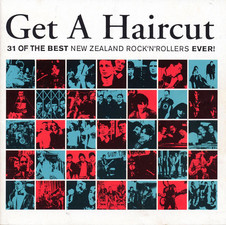
Get A Haircut - 31 Of The Best New Zealand Rock'n'Rollers Ever! (Zerox, 2004, compiled by John Baker)
John Baker’s 2004 compilation Get A Haircut showed that gutsy guitar rock was always around, reaching all the way from Johnny Devlin’s ‘Nervous Wreck’ through the more hectic approach of the 1960s rock acts, then on to the punk acts of the late 70s and early 80s.
The compilation nodded to the 90s scene in Christchurch which gave birth to the feral sound of the Hi-Tone Destroyers and the Axel Grinders, which featured John Segovia (Shaft, Don Kings, Don McGlashan and the Seven Sisters), along with Celia Mancini and Duane Zarakov (aka Pat Faigan) from King Loser. When Celia left, she was replaced by Rita le Quesne on guitar and vocals. Bassist Martin Henderson went on to form Ape Management, who relocated to Wellington and released work through Kato Records. The label was run by Andrew Tolley (Jawload, Hasselhoff Experiment) who wanted to facilitate getting local acts onto 7" vinyl, while also releasing the odd CD and bringing in imported records.
In Auckland, a parallel scene developed around the recording space opened by Bob Frisbee. He used spaces that were under demolition orders and therefore had cheap rent – first at a spot on Mayoral Drive adjacent to Aotea Square, then within the old Kiwi Bacon Factory in Kingsland. He outdid himself when he nabbed a whole four-storey building at the top of Symonds Street. The latter had previously been an old National Bank premises and the vault provided a relatively soundproof room for bands to rehearse, as long as they didn’t make the mistake of locking themselves in. For around a year, it was an all-ages venue (back when the drinking age was 20) under the name Frisbee Leisure Lounge.
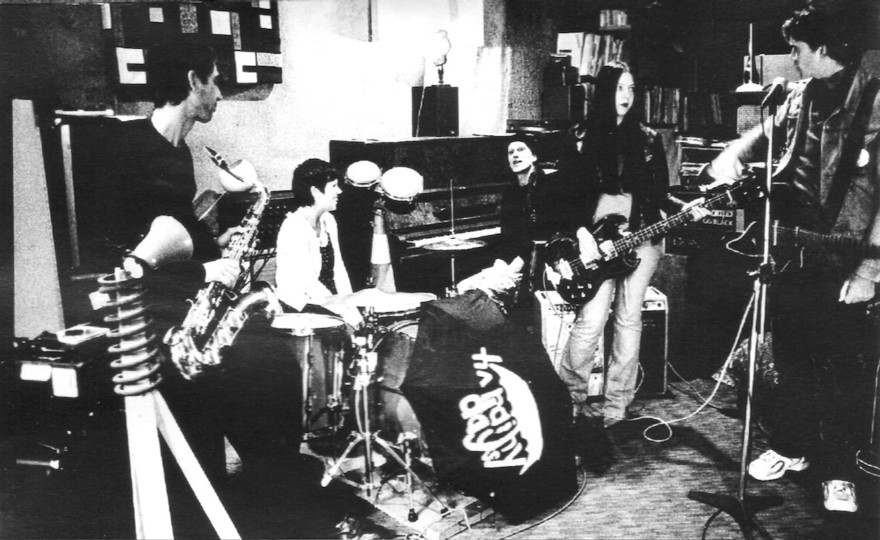
The Rainy Days: Tom, Aimee, guest pianist Angel, bassist Karin Canzek, and singer Dave Graham.
Dion Palmer was a regular and played bass in punk band Nothing At All! Palmer also filled in as guitarist for The Rainy Days, a group led by singer Dave Graham which was known for playing on the street outside venues. When The Rainy Days did play inside, they’d often set up away from the main stage. Graham was a wonderful songwriter, but a true eccentric who went through a run of musical projects – most notably, Marty Sauce and The Source (with Marty from S.M.A.K.) and WWIV. The Rainy Days gradually moved against the “guys with guitars” vibe of the scene, by having an even gender split within the band with Graham joined by saxophonist Tom Dale, drummer Aimee Egdell, and bassist Karin Canzek.
Perhaps the most influential act within the Frisbee scene was Shaft, which produced eminently catchy, timeless guitar tunes courtesy of songwriter Bob Cardy (also of AXEMEN).
Through the mid-90s, Nothing At All! made its name through heavy touring, arranged with the help of the aforementioned John Baker (Psychodaizies) who released their Frisbee-recorded album on his label Zerophonic (sister label to his Zero, Zerox, and Action! labels) with distribution through Festival Records. Tragically, Nothing At All! came to an untimely end when singer/guitarist Tony Brockwell died of cancer, aged only 21 years old.
When Dion Palmer was unceremoniously dumped from his next band The Snitches, he vowed to make it next time around. He switched back to guitar and formed The D4 with bassist Jake Harding and another musician from the Frisbee milieu, Jimmy Christmas, who had been fronting A Bit Off (a band that had Paul Foster from Nothing At All! on bass).
One of the places Nothing at All! had played repeatedly was Hamilton where the band provided a burst of inspiration to Cambridge musician Dolf de Borst. He arranged for his band Trinket to support them in Tauranga and got his dad to drive them to the show. He also began travelling up to Auckland to attend shows at Frisbee Leisure Lounge. He and his bandmates were strongly influenced by a tour by Swedish rock outfit The Hellacopters (brought over by Baker) and their album Supershitty to the Max (1996) pre-empted much of what would follow.
Trinket evolved into The Datsuns and they joined The D4 in being the last two acts that were subsequently featured on Baker’s Get A Haircut compilation. For good reason, since these were two bands which took New Zealand rock to the world.
The D4 and The Datsuns
The D4’s sound was primal rock, with lyrics to match – imploring listeners to ‘Party’ and ‘Get Loose’. The band toured Japan before it had even released an album and signed to Flying Nun, at a time when the label was moving toward rock with the addition of Liam Finn’s band Betchadupa and Christchurch group Pan Am.
The D4 used York Street Recording Studios to create a bold sound for their debut album, 6Twenty (2001), though kept Bob Frisbee producing to ensure some rawness remained.
Meanwhile in Hamilton, Dolf de Borst was keeping busy as bassist for Hamilton rockers, Trucker – a band led by singer Jamie Stone, who also fronted The Nerve and was a member of scene mainstays Mobile Stud Unit.

The Datsuns, Kings Arms, Auckland, 2002 - Simon Grigg collection
De Borst soon found himself drawn away by The Datsuns. Their live shows had the same hectic, take-no-prisoners attitude as those by The D4, but the two bands differed musically. While The D4 had a New York City, Johnny Thunders & The Heartbreakers punk-influenced sound that saw them shooting out short, to-the-point songs, The Datsuns drew from upfront 70s rock – with fast riffs and intricate guitar solos provided by Christian Livingstone, matched by the wailing vocals of De Borst.
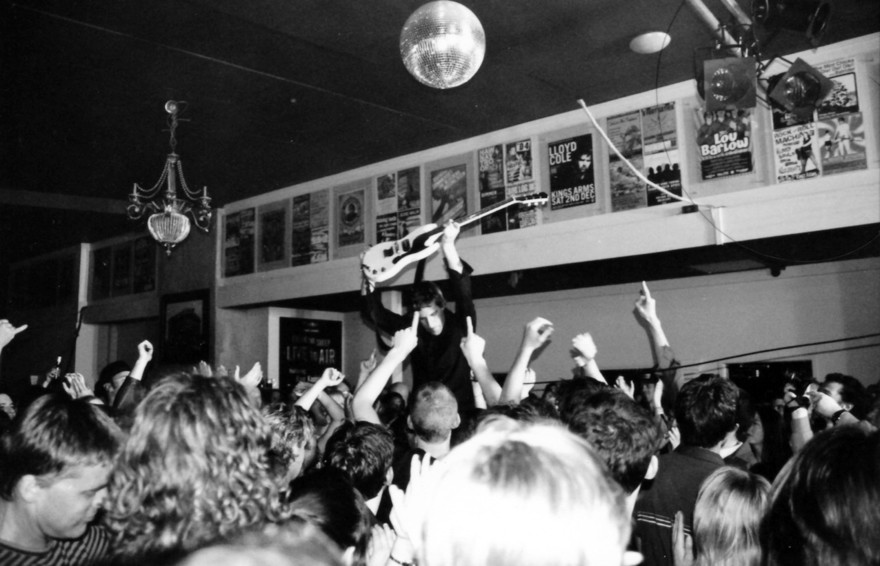
The D4 at the Kings Arms, Auckland. - Photo by Gareth Shute
John Baker encouraged both The D4 and The Datsuns to press their first singles on vinyl (via Melbourne’s Corduroy pressing plant). ‘Ladies Man’ by The D4 and ‘Super Gyration’ by The Datsuns both came out in 2000.
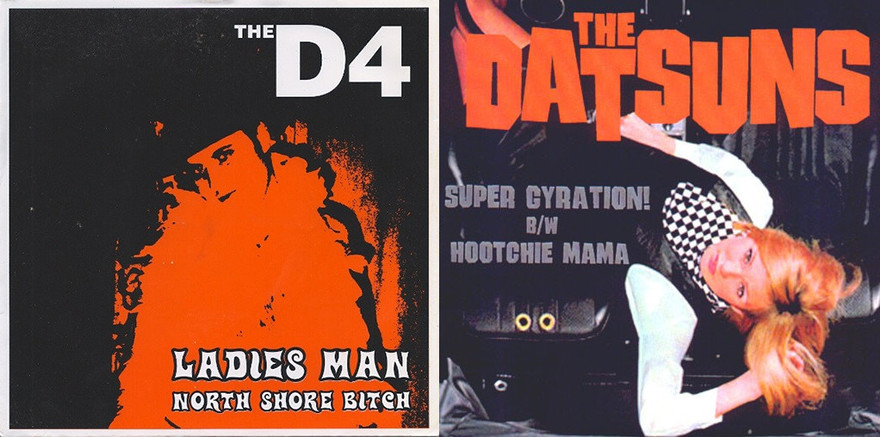
Debut 7-inch singles: The D4's 'Ladies Man'/ 'North Shore Bitch', and The Datsuns' 'Super Gyration'/ 'Hootchie Mama', both released in 2000.
Baker booked The Datsuns as support act when he brought over the White Stripes and, when his role as their tour manager continued overseas, he had The Datsuns join them for more dates in Australia and the US. Baker’s work gave him an on-the-ground view of the US bands of the time, and he was seldom impressed. He emailed Dion to get The D4 over there pronto, because they were as good as, if not better, than what he was seeing.
In 2002, both The D4 and The Datsuns played SXSW in the US for the first time. However, the real action was in the UK, where the NME was heralding the rebirth of rock’n’roll and positioning itself as the key tastemaker. The flagship bands were The Strokes (New York), The White Stripes (Detroit), and The Hives (Sweden), but the rise of The Libertines in London provided a UK angle too. The Datsuns were lauded by NME and their friend Simon Keeler (from Cargo Records in the UK) had encouraged them to approach legendary DJ John Peel. He told them that Peel liked the personal touch, so they handmade their own CD art and wrote him a letter from the band. Baker then went through a contact at the BBC to get them to Peel’s producer. Peel not only championed them on his BBC show, he arranged for them to do a prestigious Peel Session.
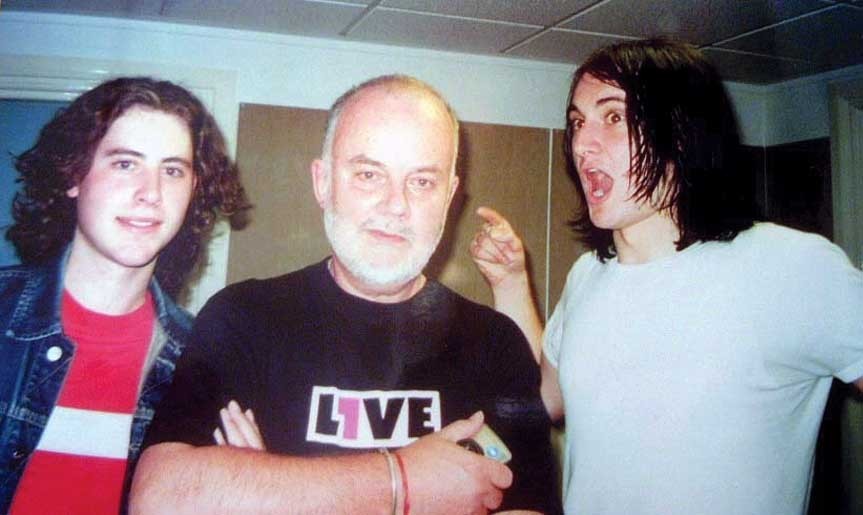
Matt Osment, John Peel and Dolf de Borst, May 2002. - Photo by Quentin Reade.
Rip It Up Archive/Simon Grigg collection
The Datsuns and The D4 were soon receiving rapturous live reviews, which led to countless record deals being thrown at them. The Datsuns signed to V2, reasoning that it was still an indie label despite its large size and might understand their ethos. Their first UK single ‘In Love’ hit No.25 and their self-titled album reached No.17. They appeared on Top of the Pops and Later with Jools Holland, and repeatedly graced the cover of the NME.
The book Meet Me In The Bathroom: Rebirth and Rock and Roll in New York City 2001–2011 provides an oral history of this era and devotes a chapter to the Columbia hotel in London where visiting bands stayed, and where The Datsuns are described as partying in the bar alongside Bobby Gillespie, Mick Rock, The Polyphonic Spree, Kings of Leon, Interpol, and Evan Dando of the Lemonheads.

Daniel "Beaver" Pooley, The D4. - Photo by Gareth Shute
The D4 also had a new record deal. Flying Nun was then owned by Mushroom Records, who signed them to their Infectious Records imprint in the UK. Even more impressively, they had Alan McGee as their manager – the founder of Creation Records, who’d broken bands such as Jesus and Mary Chain, Primal Scream, and Oasis. This led to a deal with heavyweight US label Hollywood Records, whose senior vice president Geoffrey Weiss happened to be a fan of New Zealand rock’n’roll from the present right back to the sixties. The label put a hefty promotional budget behind them.
When both The D4 and The Datsuns appeared at SXSW in 2003, they blew away those in attendance and each gained slots on popular late night talk shows: The Datsuns appeared on Conan O’Brien and The D4 appeared on The Late Show With David Letterman.
However, the US was a hard nut to crack. College radio had already tracked the rise of The Strokes and the bands out of the Detroit scene (White Stripes, Von Bondies), so The Datsuns and The D4 were assumed to be newcomers jumping on the bandwagon. What’s more, music blogs were in ascendency, and they had a knee jerk reaction to anything the old media might have championed, which can be seen in the savage reviews given to albums by The D4 and The Datsuns in Pitchfork (both 2.8/10).
The Second Wave
Back in Aotearoa, there were more acts raring to go. Wellington band Two-Lane Blacktop formed in 2002 and self-released a string of EPs. By the following year they’d hit Australia and released a 7" single ‘The Rat’ through In-fidelity Records, receiving play on John Peel’s radio show. They toured the US and were soon in negotiations with a label there. They went home to Wellington to record an album and undertook a tour supporting Shihad.
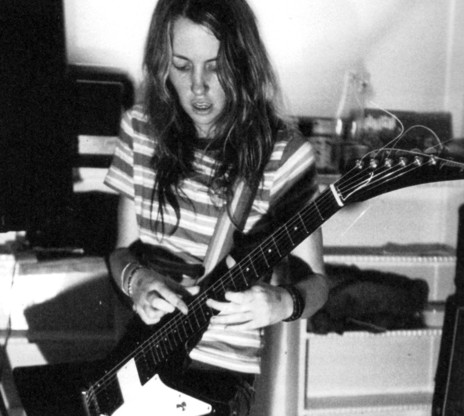
Two-Lane Blacktop's Pip Brown, later known as Ladyhawke. - Photo by Ian Jorgensen
However, the band was coming apart internally. On their last show with Shihad, Two-Lane Blacktop frontman Matthew Harrop smashed his guitar in frustration and the band folded soon after. They’d already booked tickets to Melbourne to tour with Modey Lemon, so their guitarist Pip Brown went anyway and sat on the plane beside the three empty seats of her former bandmates. She formed Teenager with Nick Littlemore and joined him in Sydney, but when he became too busy with his other projects (PNAU, Empire of the Sun) she launched Ladyhawke.
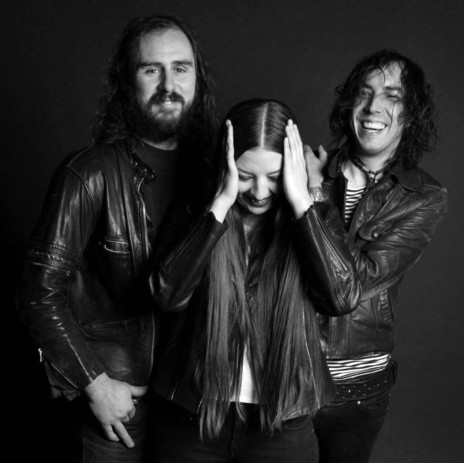
The Rock and Roll Machine: Rich Mixture, Karin Canzek, Matt Stroobant. - Publicity photo
Waiting in the wings behind The D4 was another act from within the Frisbee Leisure Lounge scene. Members of The Rock and Roll Machine all had connections to The D4 – singer/guitarist Matt Stroobant had been in A Bit Off with Jimmy Christmas, drummer Paul Robertson played in The Rainy Days with Dion, and Karin Canzek joined that band on bass after he left. Rich Mixture later took over on drums for The Rock and Roll Machine and was an early member of The D4. Dion recorded The Rock and Roll Machine’s first three-song 7" single on his four-track and it was released through Zerox. Unfortunately, label owner John Baker went overseas without passing on the vinyl, and Paul Robertson had to break into his house to retrieve them for the release show.
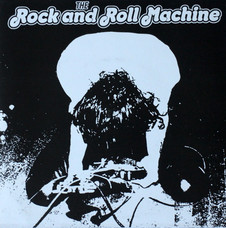
The Rock and Roll Machine 7" (Zerox, 2000)
Stroobant was known for fiery live performances but took it too far by leaping off a stage and breaking his leg. The Rock and Roll Machine followed the same playbook – releasing 7" singles and touring the UK and US, before they looked at recording an album. They performed at the CMJ Music Festival in New York just as the rock revival was in full swing and joined a line-up at the iconic Bowery Ballroom that also included The Kills, Electric Six, The Datsuns, The Dirtbombs and The Von Bondies. While in London, they recorded a 7" at Toe Rag Studios, which was subsequently released on French label Pishark Records.
The Rock and Roll Machine’s self-titled debut (2006) was concurrently released with a 7" single ‘Creature of the Night’ through Hellsquad Records – the label run by The Datsuns. By this stage they were a mainstay of an Auckland rock scene that also included the unfortunately named Slavetrader. The Rock and Roll Machine’s local support slots included some groundbreaking acts such as New York Dolls (at Auckland’s St James Theatre), MC5/DKT, and Dead Moon. However Matt’s injury continued to affect him, making touring a painful endeavour, so the band gradually wound down.
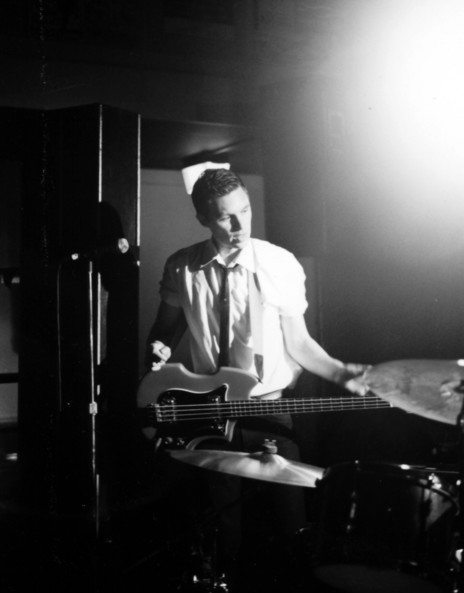
Dylan Herkes playing in The Chandeliers. - Photo by Gareth Shute
Even more underground was the music of The Mysterious Tape Man (aka Dylan Herkes), who performed with his face entirely wrapped in tape. Herkes started the label Stink Magnetic in Pahiatua (30km east of Palmerston North) and specialised in the lo-fi, surf-infused rock’n’roll, with bands like The Chandeliers and The Damned Evangelist. Stink Magnetic had a sympatico relationship with Kato Records and there was crossover – such as when Tolley appeared on an album by the Don Kings released through Stink Magnetic or when The Mysterious Tape Man released a 7" through Kato. These were cult releases for sure but reached an overseas underground audience through Tolley’s network of connections.
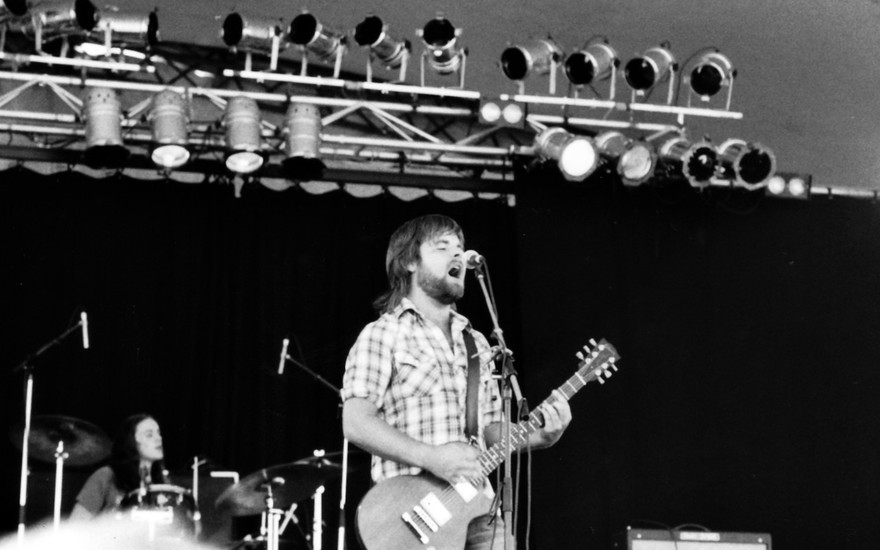
The Have at Big Day Out, Auckland, 2006. - Photo by Gareth Shute
Like Stink Magnetic, the musicians behind The Have also came from small town New Zealand. The core members grew up in Whanganui and originally played in a high-school band with classmate Seth Haapu before deciding to go in their own direction. They adopted a classic rock sound and managed to win Smokefreerockquest in 2002. There was more than a hint of The Datsuns on their hard-riffing single ‘The Fuzz’ and they were picked up by Auckland’s top music management agency, CRS. They headed to SXSW in 2004 and 2005, which led to offers of record deals, though only the type of one-sided deal that a young act should be wary of. Instead, they decided to stay independent and returned home to record an album.
The trouble was that the clock was ticking by this stage. The hype around guitar bands had faded, as the fickle music press moved on to a new flavour of the month. The Have recorded their album Back To The Burning Wreck with US producer Barrett Jones (Foo Fighters, Evermore) but it didn’t arrive until 2006, by which stage the bubble had burst. The Have played at Big Day Out, then the key members moved to Berlin and started over as Sun and The Wolf, adopting more of a psychedelic sound.
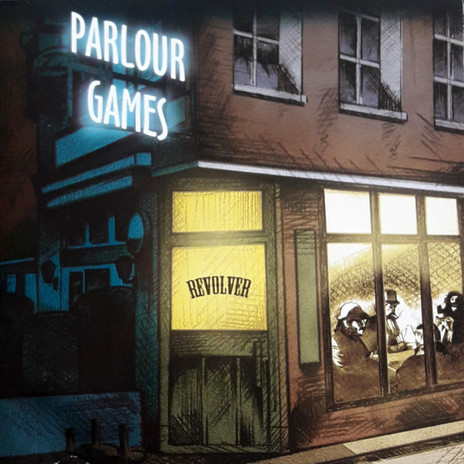
Revolver - Parlour Games (2006)
Revolver were a spirited young band who had an even briefer run, though their album Parlour Games (2006) did receive a win at that year’s music awards, with the Sound Engineer of the Year going to their collaborator, Chris van de Geer.
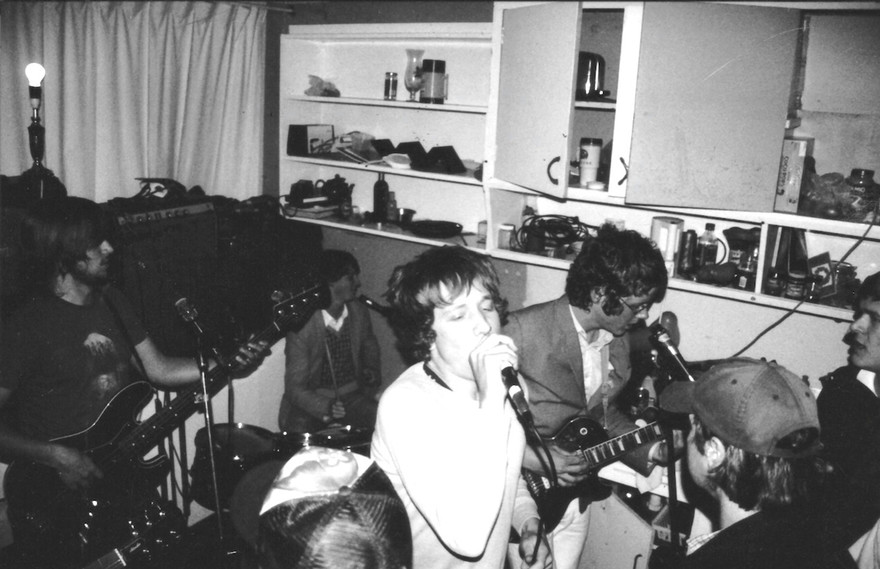
The Checks playing in the kitchen of Lil Chief Records. - Photo by Gareth Shute
The timing issue was similar for The Checks. They had also formed at high school and were packing out venues before they’d even graduated. It was a fortunate time to be a band on Auckland’s North Shore, since Rikki Morris was running his studio out of The Depot in Devonport. The Checks were so popular that they managed to convince local bar The Masonic Tavern into having all-ages shows in the afternoon (for their teen fans), followed by a licensed show at night. A raft of other bands came through behind them, including The Electric Confectionaires, White Birds and Lemons, and The Earlybirds. The scene even had its own festival, Devonstock.
NME editor Conor McNicholas saw The Checks play in Auckland and booked them for the “NME New Music Tour” of the UK in May 2005. That same year, they also supported The Hives in Japan and Oasis in Australia. They signed a deal with UK label Full Time Hobby (through Sony/BMG UK) and relocated to London to record with Ian Broudie from The Lightning Seeds. Their album Hunting Whales (2007) struggled to capture the rasping power of their live shows, but its best moments (‘Take Me There’, ‘What You Heard’) surely would’ve been hits if the world had been in the mood to listen. Their album also arrived just as CD sales were falling through the floor, so labels were tightening their budgets. They toured across Europe but failed to make an impact.
Surviving the Hype
The D4’s deal with Hollywood Records soon showed its downside. They were embarrassed to arrive at one US gig supporting the Von Bondies to find photos of themselves plastered on the walls. They appeared like total sellouts. Mid-tour, they were sent into Sound City studio in LA with an arrogant producer who re-recorded their song ‘Heartbreaker’ but coated the vocals with weird effects.
They returned to London and recorded a second album, Out of My Head (2005), but both Infectious and Hollywood Records turned it down so they released it through Flying Nun international. They reverted from travelling in a tour bus back to squeezing into a van, heading off across Europe in support of The Hives. At least, they still had one more killer single to deliver – the explosive ‘What I Want’. Alan McGee had it pressed as a 7" for his Poptones label, but it didn’t hit stores until after the tour had ended. The band split, though each member continued playing music in the decades that followed.
The Datsuns had better luck. Their second album was recorded by Led Zeppelin’s John Paul Jones. Their record label arranged the pairing, perhaps driven more by the desire for striking headlines rather than any practical considerations – but it worked out. The Datsuns sounded just as ferocious on Outta Sight Outta Mind (2004), which produced the UK Top 50 single ‘Blacken My Thumb’ (and the album reached the Top 50 in Australia).
They slugged away at breaking the US without any luck, but the heights they’d achieved in the UK and Europe meant their success had a long tail. They continued releasing albums every few years and touring widely. For example, their tour for Deep Sleep (2014) included two dozen dates across the UK/Europe and another dozen throughout Australasia, with a short follow-up jaunt through Japan.

Ed Knowles and Sven Pettersen at the Grey Lynn Bowling Club in 2005. - Photo by Gareth Shute
Of the second wave acts, The Checks were the most enduring. Their next two albums followed their debut into the Top 30 and they had a charting hit with ‘You and Me’ which also gained millions of streams when Spotify arrived. Their sound shifted markedly over this time, settling into a sultry groove that stayed with singer Ed Knowles and guitarist Sven Pettersen when they re-started as Racing.
Some of the instigators who’d helped propel the movement at home remained active too. John Baker continued to tour bands and release records, and Bob Frisbee kept his studio running while also doing live sound for bands both overseas (Princess Chelsea in the US/Europe, The Beths in Australia) and locally (Don McGlashan, Nadia Reid, Tiny Ruins, and many others).
The sudden rise and fall of retro rock was cruel in some ways – dangling a shortcut route to success, with a very limited time window. Soon after, the sound of the moment switched to “electropop”, which was perfect timing for Pip Brown’s Ladyhawke project, helping her debut album into the Top 20 in the UK and Australia.
The Datsuns had seen the writing on the wall from the start, saying in their song ‘You Build Me Up (To Bring Me Down)’:
“Everywhere, even your hometown
Finally decides you’ve made a sound
They turn their head and stare at everything you got
And make you something you are not.”
Still, for a moment two of the best rock’n’roll acts in the world had been from Aotearoa and the live scene at home was abuzz with hot young acts chomping at their coattails.
The D4 remained popular enough in New Zealand that when they briefly reformed in 2018 for a tour, they were put on the main stage of the Auckland City Limits festival. It was clear the flame still burned, with Dion spraying painting The D4 onto a guitar speaker then setting it alight.
The Datsuns never broke up, even after Dolf de Borst moved to Sweden. He now lives in Stockholm, the same city as the band that first inspired them – The Hellacopters – and he became their full-time bass player. In 2023, The Datsuns joined them for a European tour.
Every four years or so, The Datsuns release a new album and hit the road once more. Each night, there is a mighty roar from the crowd as they finish their set with ‘MF From Hell’, bringing the same vibrant intensity, despite the decades that have passed.
--